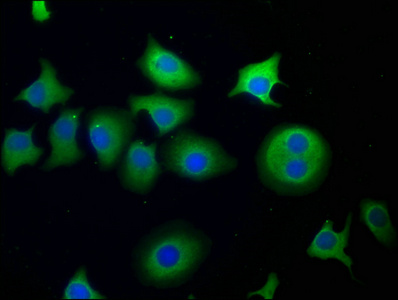SNF8 Antibody
-
货号:CSB-PA856945LA01HU
-
规格:¥440
-
促销:
-
图片:
-
Immunofluorescence staining of A549 cells with CSB-PA856945LA01HU at 1:50, counter-stained with DAPI. The cells were fixed in 4% formaldehyde, permeabilized using 0.2% Triton X-100 and blocked in 10% normal Goat Serum. The cells were then incubated with the antibody overnight at 4°C. The secondary antibody was Alexa Fluor 488-congugated AffiniPure Goat Anti-Rabbit IgG(H+L).
-
-
其他:
产品详情
-
产品名称:Rabbit anti-Homo sapiens (Human) SNF8 Polyclonal antibody
-
Uniprot No.:Q96H20
-
基因名:
-
别名:Dot3 antibody; ELL associated protein of 30 kDa antibody; ELL-associated protein of 30 kDa antibody; ESCRT-II complex subunit VPS22 antibody; hVps22 antibody; snf8 antibody; SNF8 ESCRTII complex subunit homolog (S cerevisiae) antibody; SNF8_HUMAN antibody; Vacuolar sorting protein SNF8 antibody; Vacuolar-sorting protein SNF8 antibody; VPS22 antibody
-
宿主:Rabbit
-
反应种属:Human
-
免疫原:Recombinant Human Vacuolar-sorting protein SNF8 protein (1-258AA)
-
免疫原种属:Homo sapiens (Human)
-
标记方式:Non-conjugated
本页面中的产品,SNF8 Antibody (CSB-PA856945LA01HU),的标记方式是Non-conjugated。对于SNF8 Antibody,我们还提供其他标记。见下表:
-
克隆类型:Polyclonal
-
抗体亚型:IgG
-
纯化方式:Antigen Affinity Purified
-
浓度:It differs from different batches. Please contact us to confirm it.
-
保存缓冲液:Preservative: 0.03% Proclin 300
Constituents: 50% Glycerol, 0.01M PBS, pH 7.4 -
产品提供形式:Liquid
-
应用范围:ELISA, IF
-
推荐稀释比:
Application Recommended Dilution IF 1:50-1:200 -
Protocols:
-
储存条件:Upon receipt, store at -20°C or -80°C. Avoid repeated freeze.
-
货期:Basically, we can dispatch the products out in 1-3 working days after receiving your orders. Delivery time maybe differs from different purchasing way or location, please kindly consult your local distributors for specific delivery time.
相关产品
靶点详情
-
功能:Component of the endosomal sorting complex required for transport II (ESCRT-II), which is required for multivesicular body (MVB) formation and sorting of endosomal cargo proteins into MVBs. The MVB pathway mediates delivery of transmembrane proteins into the lumen of the lysosome for degradation. The ESCRT-II complex is probably involved in the recruitment of the ESCRT-III complex. The ESCRT-II complex may also play a role in transcription regulation by participating in derepression of transcription by RNA polymerase II, possibly via its interaction with ELL. Required for degradation of both endocytosed EGF and EGFR, but not for the EGFR ligand-mediated internalization. It is also required for the degradation of CXCR4. Required for the exosomal release of SDCBP, CD63 and syndecan.
-
基因功能参考文献:
- data describe an unappreciated role for EAP30 in IRF3-dependent innate antiviral response in the nucleus. PMID: 29084253
- Taken together, these data suggest an active role for ESCRT-II and CHMP6 in ESCRT-mediated abscission PMID: 25232011
- Modulating SNF8 expression levels alters the TRPC6 channel current and can modulate activation of NFAT-mediated transcription downstream of gain-of-function mutant TRPC6. PMID: 23171048
- mammalian ESCRTII is made up of hVps25p, hVps22p, and hVps36p and may be redundant, cargo-specific, or not required for protein sorting at the multivesicular body PMID: 16371348
- there are probably multiple pathways for protein sorting/multivesicular body vesicle formation in human cells and that human immunodeficiency virus type 1 does not utilize an ESCRT-II-dependent pathway to leave the cell PMID: 16973552
- Vps22 has an important role in ligand-induced EGFR and CXCR4 turnover; termination of EGF signaling occurs prior to ESCRT-II engagement PMID: 17714434
显示更多
收起更多
-
亚细胞定位:Cytoplasm. Endosome membrane. Nucleus. Late endosome membrane. Note=Recruited to the endosome membrane to participate in vesicle formation.
-
蛋白家族:SNF8 family
-
数据库链接:
HGNC: 17028
OMIM: 610904
KEGG: hsa:11267
STRING: 9606.ENSP00000421380
UniGene: Hs.127249
Most popular with customers
-
-
YWHAB Recombinant Monoclonal Antibody
Applications: ELISA, WB, IF, FC
Species Reactivity: Human, Mouse, Rat
-
Phospho-YAP1 (S127) Recombinant Monoclonal Antibody
Applications: ELISA, WB, IHC
Species Reactivity: Human
-
-
-
-
-






















